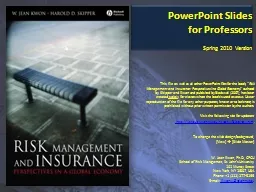PPT-PowerPoint Slides for Professors
Author : pasty-toler | Published Date : 2018-09-26
Spring 2010 Version This file as well as all other PowerPoint files for the book Risk Management and Insurance Perspectives in a Global Economy authored by Skipper
Presentation Embed Code
Download Presentation
Download Presentation The PPT/PDF document "PowerPoint Slides for Professors" is the property of its rightful owner. Permission is granted to download and print the materials on this website for personal, non-commercial use only, and to display it on your personal computer provided you do not modify the materials and that you retain all copyright notices contained in the materials. By downloading content from our website, you accept the terms of this agreement.
PowerPoint Slides for Professors: Transcript
Download Rules Of Document
"PowerPoint Slides for Professors"The content belongs to its owner. You may download and print it for personal use, without modification, and keep all copyright notices. By downloading, you agree to these terms.
Related Documents














